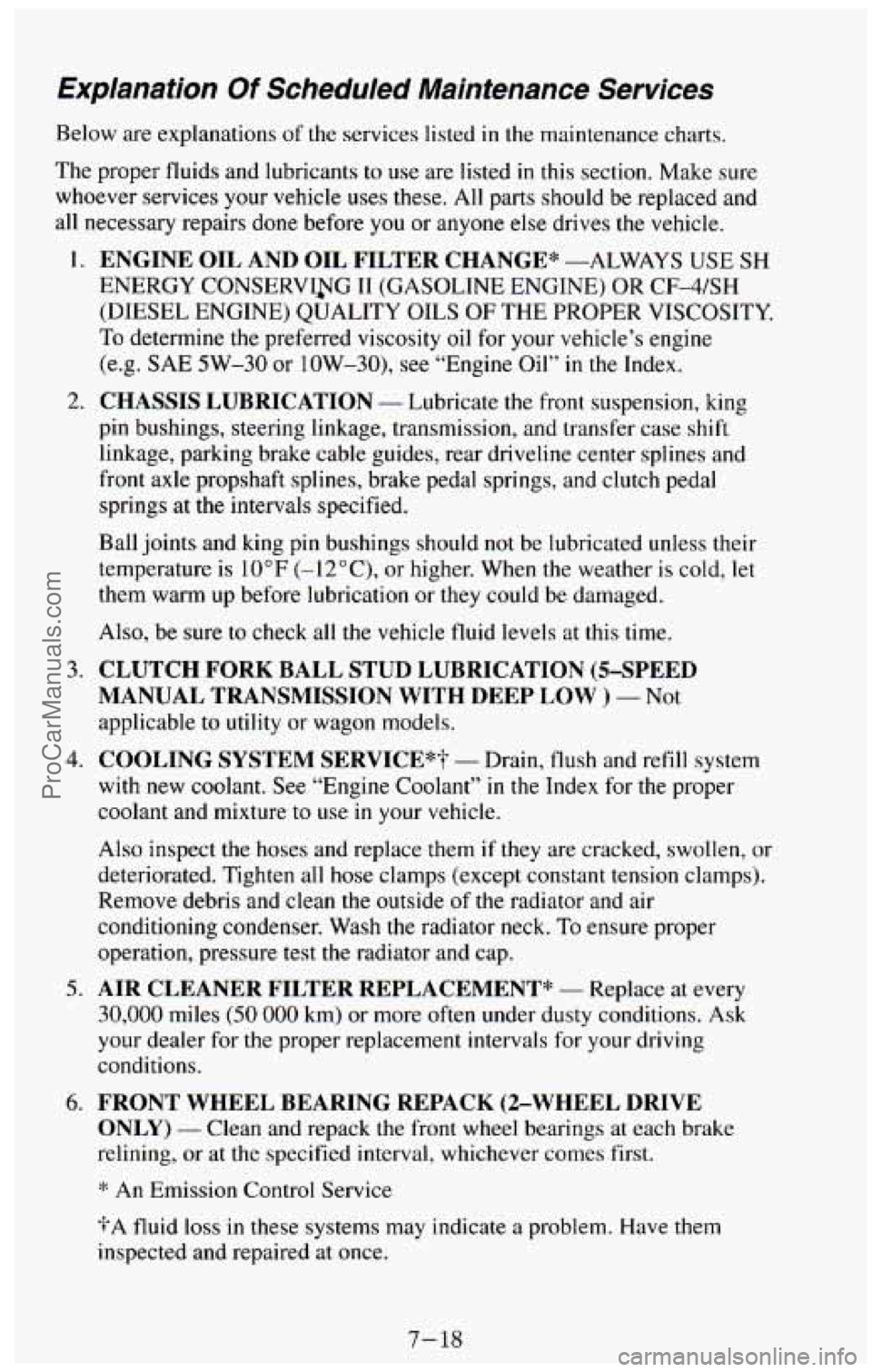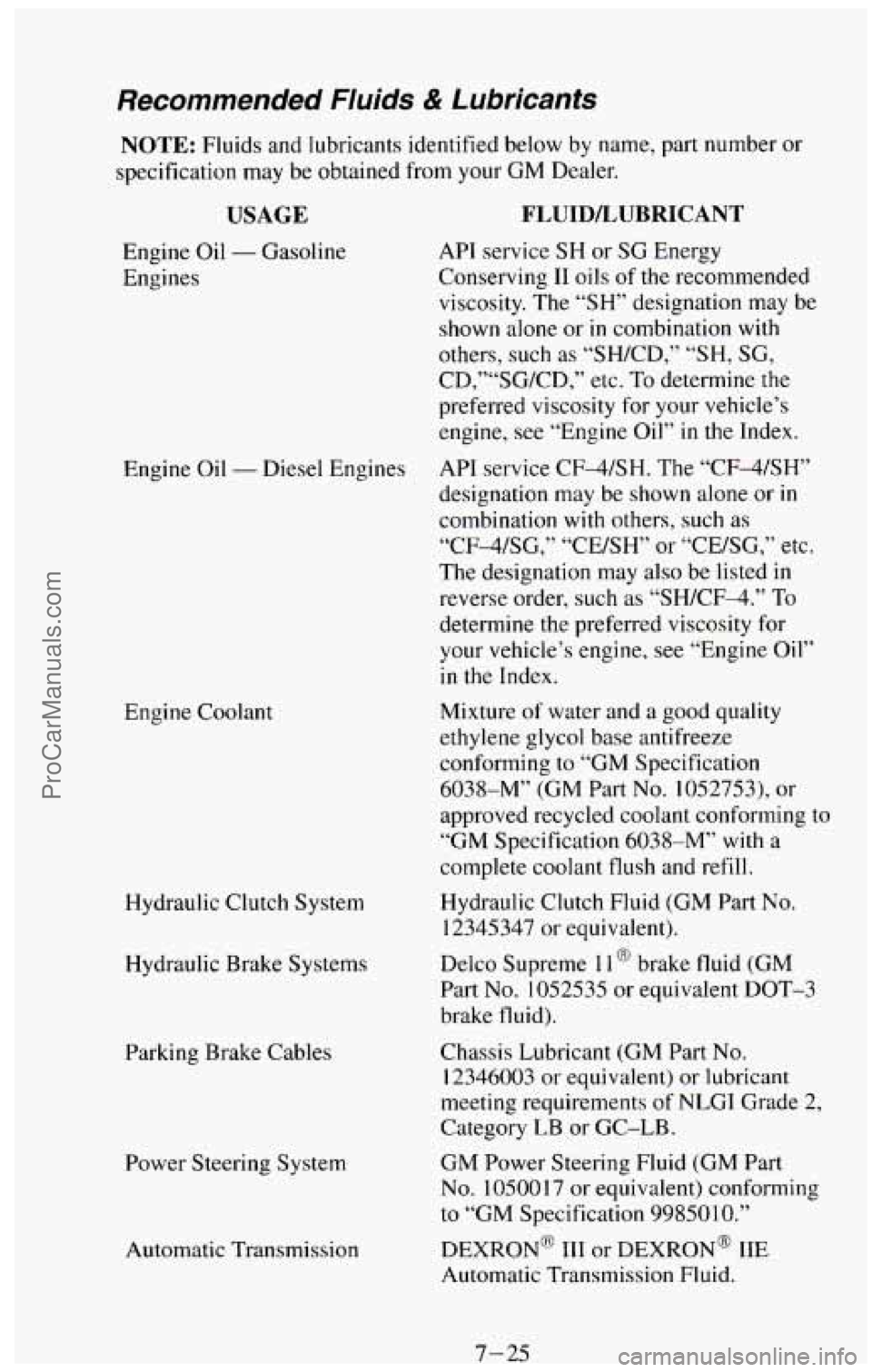Page 282 of 385
Adding Coolant -Gas Engines
The coolant recovery
tank is located on the
passenger side at the
rear comer of the
engine compartment
To Check Coolant
When your engine is cold, the coolant level should be at COLD, or a little
higher. When your engine
is warm, the level should be up to HOT, or a little
higher.
To Add Coolant
If you need more coolant, add the proper mix at the coolant recovery tank.
Add coolant mix at the recovery tank, but be careful not to spill it.
6-37
ProCarManuals.com
Page 283 of 385
Adding Coolant -Diesel Engines
.. The coolant surge tank
is located on the
passenger side at the
rear corner
of the
engine compartment
To Check Coolant
When your engine is cold, the coolant level should be at the COLD mark,
or
a little higher. When your engine is warm, the level should be above the
COLD mark.
If this light comes on,
it means you're low
on engine coolant.
To Add Coolant
If you need more coolant, add the proper mix ut the surge tank, but only
when the
engine is cool.
Open the bleed valve
on the thermostat housing to allow trapped air out of
the system. Close the bleed valve when coolant begins to flow out.
6-38
ProCarManuals.com
Page 284 of 385
Radiator Pressure Cap-Gas Engines
I I
The radiator pressure
cap must be tightly
installed with the
arrows on the cap
lined up with the
ovefflow tube on the
radiator filler neck.
NOTICE:
Your radiator cap is a 15 psi (105 kPa) pressure-type cap and
must be tightly installed
to prevent coolant loss and possible
engine damage from overheating. Be sure the arrows on the cap
line up with the overflow tube on the radiator filler neck.
ProCarManuals.com
Page 285 of 385
Surge Tank Pressure Cap- Diesel Engines
The surge tank
pressure cap must be
tightly installed with
the arrows
on the cap
lined up with the top
tube
of the coolant
surge tank.
NOTICE:
Your surge tank pressure cap 1s a unique 15 psi (105 kPa)
pressure-type cap for use with surge tank cooling systems only.
It must be tightly installed to prevent coolant loss and possible
engine damage from overheating. Be sure the arrows on the cap
line up with the top tube
of the coolant surge tank.
Thermostat
Engine coolant temperature is controlled by a thermostat in the engine
coolant system. The thermostat stops the flow
of coolant through the
radiator until the coolant reaches a preset temperature.
When you replace your thermostat, an
AC@ thermostat is recommended.
Power Steering Fluid
I NOTICE:
Always turn the engine off before checking or adding power
steering
fluid. The power steering pump cap is close to the fan
and other moving parts.
6-40
ProCarManuals.com
Page 332 of 385
LAMP OR BULB
INSTRUMENT
P ANEL
Transmission Indicator (PRNDL)
Daytime Running Lights Indicator?'
Charging System Indicator Lamp
Instrument Cluster Illumination -Gage
Cluster
Instrument Cluster Illumination
-Tachometer Cluster
Headlamp Beam Indicator
Directional Signal Indicator
Brake Warning Indicator
Safety Belt Warning
Check Gages Indicator Malfunction Indicator ("Service Engine
Soon") Lamp
Upshift Indicator
Glow Plugs Lamp*:"
Low Coolant Lamp**
Water
in Fuel Lamp**
Service Throttle
Soon Lamp**
'k*Diesel only
'fCanadian Vehicles only
TRADE NO.
161 74
74
194
194 74
74
74
74
74 74
74
74 74
74
74
6
6-87
ProCarManuals.com
Page 351 of 385

Explanation Of Scheduled Maintenance Services
Below are explanations of the services listed in the maintenance charts.
The proper fluids and lubricants to
use are listed in this section. Make sure
whoever services your vehicle uses these.
All parts should be replaced and
all necessary repairs done before you or anyone else drives the vehicle.
1. ENGINE OIL AND OIL FILTER CHANGE* -ALWAYS USE SH
ENERGY CONSERVIJTG TI (GASOLINE ENGINE) OR CF-4/SH
(DIESEL ENGINE) QUALITY OILS OF THE PROPER VISCOSITY.
To determine the preferred viscosity oil for your vehicle’s engine
(e.g.
SAE 5W-30 or low-30), see “Engine Oil” in the Index.
2. CHASSIS LUBRICATION - Lubricate the front suspension, king
pin bushings, steering linkage, transmission, and transfer case shift
linkage, parking brake cable guides, rear driveline center splines and
front axle propshaft splines, brake pedal springs, and clutch pedal
springs at the intervals specified.
Ball joints and king pin bushings should not be lubricated unless their
temperature is
10°F (-12”C), or higher. When the weather is cold, let
them warm up before lubrication or they could be damaged.
Also, be sure to check all the vehicle fluid levels at this time.
3. CLUTCH FORK BALL STUD LUBRICATION (5-SPEED
MANUAL TRANSMISSION
WITH DEEP LOW ) - Not
applicable to utility or wagon models.
4. COOLING SYSTEM SERVICE*? - Drain, flush and refill system
with new coolant. See “Engine Coolant’’
in the Index for the proper
coolant and mixture to use
in your vehicle.
Also inspect the hoses and replace them
if they are cracked, swollen, or
deteriorated. Tighten all
hose clamps (except constant tension clamps).
Remove debris and clean
the outside of the radiator and air
conditioning condenser. Wash the radiator
neck. To ensure proper
operation, pressure test the radiator and cap.
5. AIR CLEANER FILTER REPLACEMENT* - Replace at every
30,000 miles (50 000 km) or more often under dusty conditions. Ask
your dealer for the proper replacement intervals
for your driving
conditions.
6. FRONT WHEEL BEARING REPACK (2-WHEEL DRIVE
ONLY)
- Clean and repack the front wheel bearings at each brake
relining, or at the specified interval, whichever comes first.
4’ An Emission Control Service
*A fluid loss in these systems may indicate a problem. Have them
inspected and repaired at once.
7- 18
ProCarManuals.com
Page 358 of 385

Recommended FIuids & Lubricants
NOTE: Fluids and lubricants identified below by name, part number or
specification may
be obtained from your GM Dealer.
USAGE
Engine Oil - Gasoline
Engines
Engine Oil
- Diesel Engines
Engine Coolant Hydraulic Clutch System
Hydraulic Brake Systems Parking Brake Cables
Power Steering System Automatic Transmission
FLUIDLUBRICANT
API service SH or SG Energy
Conserving
I1 oils of the recommended
viscosity. The
“SH” designation may be
shown alone or
in combination with
others, such as “SH/CD,”
“SH, SG,
CD,”“SG/CD,” etc. To determine the
preferred viscosity for your vehicle’s
engine, see “Engine Oil”
in the Index.
API service CF4SH. The “CF4SH”
designation may be shown alone or
in
combination with others, such as
“CF-4/SG,” “CE/SH” or “CE/SG,” etc.
The designation may also be listed
in
reverse order, such as “SH/CF-4.” To
determine the preferred viscosity for
your vehicle’s engine, see “Engine Oil”
in the Index.
Mixture
of water and a good quality
ethylene glycol base antifreeze
conforming to “GM Specification
6038-M” (GM Part
No. 1052753), or
approved recycled coolant conforming to
“GM Specification 6038-M” with a
complete coolant flush and refill.
Hydraulic Clutch Fluid
(GM Part No.
12345347 or equivalent).
Delco Supreme
11 @ brake fluid (GM
Part
No. 1052535 or equivalent DOT-3
brake fluid).
Chassis Lubricant (GM Part
No.
12346003 or equivalent) or lubricant
meeting requirements of
NLGI Grade 2,
Category LB or GC-LB.
GM
Power Steering Fluid (GM Part
No. 10500 17 or equivalent) conforming
to “GM Specification
99850 10.”
DEXRON~ TTI or DEXRON~ IIE
Automatic Transmission Fluid.
7-25 ProCarManuals.com
Page 362 of 385
Service Station Checks
It is important for you or a service station attendant to perform these
under-hood checks at each
fuel fill.
Check the engine oil level and add if necessary.
Check the engine coolant level in the recovery bottle and add if
necessary.
Check the windshield washer fluid level and add if necessary.
See these items
in the Index for information on how to check them.
7-29 ProCarManuals.com